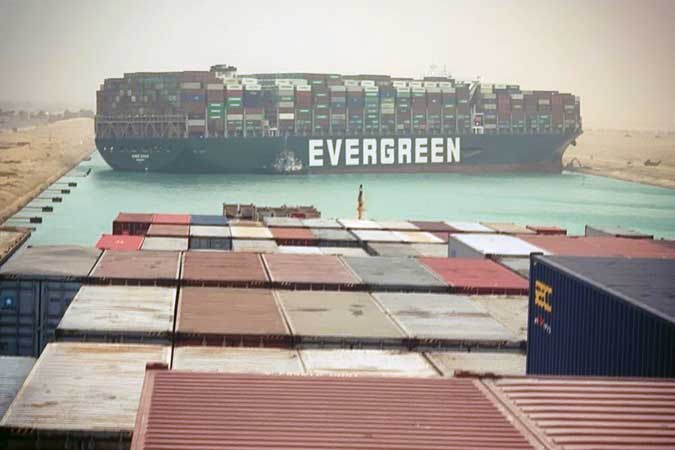A GIANT container ship ran aground in the Suez Canal, blocking off one of the world’s busiest maritime trade routes that’s vital for the movement of everything from oil to consumer goods.
The hull of Ever Given, one of the biggest container ships in operation, became wedged lengthways across the canal early Tuesday in Egypt, causing a pileup of at least 100 vessels seeking to transit between the Red Sea and Mediterranean, according to ship brokers and mapping data compiled by Bloomberg.
Ever Given “was grounded accidentally after deviating from its course due to suspected sudden strong wind,” Taiwan-based Evergreen Line, the time charterer of the vessel, said in an emailed response to questions.
Evergreen has urged the vessel’s owners to work with “relevant authorities including the canal management bureau to help the ship get out of trouble as soon as possible,” according to an emailed statement from the firm. Japan’s Shoei Kisen Kaisha Ltd., among those listed as the ship’s owner, declined to comment.
“The salvage operation with tugs is under way, and hopefully the vessel will be freed soon, but it could last days” as checks are made on the damage to the ship, said Ralph Leszczynski, head of research at shipbroker Banchero Costa & Co.
Ever Given was en route from China to Rotterdam. The crew are safe and accounted for, and there have been no reports of injuries or pollution, according to the ship’s manager Bernhard Schulte Shipmanagement. Ship tracking data showed the vessel was still in the same position as of about 2 a.m. Wednesday in Cairo. A spokesperson for the Suez Canal Authority couldn’t be reached for comment outside usual office hours.
PILEUP
The blockage has led to a big pileup in other ships in the area. About 42 vessels either in the northbound convoy or arriving to transit the canal northbound are now waiting for the grounded vessel to be re-floated, Leth Agencies, one of the top providers of Suez Canal crossing services, said in a notice to clients. About 64 vessels traveling southbound were also affected. Oil prices briefly rose on news of the disruption before pulling back.
At 400 meters in length, the vessel that was built in Japan about three years ago is longer than the Eiffel Tower laid on its side. Shipping companies have been turning to mega-sized vessels to help improve economies of scale, while some key routes — including the Suez Canal — being widened and deepened over the years to accommodate them.
“It could also take some time to move the vessel given that it would be loaded almost full,” said Park Moo-Hyun, an analyst at Hana Financial Investment Co. in Seoul. “This is going to delay a lot of the goods on one of the world’s busiest trade lanes.”
The 193-kilometer-long (120 miles) Suez Canal, which opened in 1869, is among the most trafficked waterways in the world, utilized by oil tankers shipping crude from the Middle East to Europe and North America. About 12% of global trade, almost 10% of seaborne oil trade and 8% of global LNG passes through the canal.
The canal has been the site of occasional groundings that have halted shipping. Tugboats managed to get the OOCL Japan unstuck a few hours after it ran aground in October 2017, while the containership Maersk Shams was briefly stuck a year earlier. In one of the most serious delays, the canal was closed for three days in 2004 after an oil tanker, Tropic Brilliance, got lodged. The ship was finally freed after 25,000 tons of oil was pumped out.
Any prolonged disruption would mean ships need to reroute, which would likely drive up freight costs, said Chun Hyungjin, research fellow at Korea Maritime Institute. Ships could bypass it by going around Africa via the Cape of Good Hope, but that would add about two extra weeks to the voyage from Asia to Europe, leading to significant extra costs and disrupting all schedules, said Banchero’s Mr. Leszczynski.
The shipping industry has had a tumultuous year since the COVID-19 pandemic began roiling global trade in 2020. As countries closed borders to try keep the virus under control, exports from China surged, leading to a dearth of containers and sending maritime rates soaring. The pandemic also exacerbated labor abuse in the industry, with thousands of seafarers stuck on vessels beyond the expiration of their contracts and past the requirements of globally accepted safety standards. — Bloomberg

